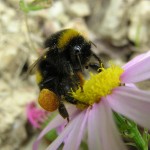by Catherine Haug, March 18, 2013
(photo, right, from Wikipedia)
The same chemical factors that are harming honeybees (colony collapse disorder) may also be having a negative impact on ground-dwelling bumblebees.
But that’s not the only thing endangering our native bumblebees. And as we lose honeybees, our native pollinators like bumblebees and mason bees will become increasingly important. We need to do all we can to ensure their survival and increase, or we will have serious problems in our food supply.
According to a short article in April/May issue of National Wildlife Magazine: Bumblebees seek biodiverse blooms, there are two things each of us can do to help bumblebees. Two things that have nothing to do with pesticides and other chemicals:
Ideas to help bumblebees:
- Plant herbs and flowers with biodiverse blooms – mix species in the same patch;
- Reduce local use of pavement (such as roads, driveways, walkways).
These recommendations come as a result of a new study at the University of Texas – Austin and the University of California-Berkley, published int he Proceedings of the National Academy of Sciences. “The study, focused on native California bumble bee species, found that pavement for roads and other structures was a key factor in the bee’s nesting decline. They also found that bees were more attracted to species-rich patches of flowers than to dense patches of a few species.” (1) .
To this I would add that planting flowering native species – native to NW Montana – will help our own bumblebees. It also helps to discover where bumblebees are dwelling below ground on your property, and do your best not to disturb their nests. They favor protected sites under shrubbery, especially native shrubs that many of us call “weeds,” like snowberry.
Why should you be concerned? “‘We are potentially in a pollinator crisis,’ says Shalene Jha, lead author and assistant professor of biology at the University of Texas. ‘Understanding how bees move around the landscape can help us both preserve biodiversity and improve crop yields.'” (1)
References and for more information:
- National Wildlife Magazine, April/May 2013 issue
- National Wildlife Federation: The Buzz on Native Pollinators
- National Wildlife Federation: Gardening With a Good-Neighbor Policy
- Xerces Society: Bumble bee identification
See also other articles on The EssentiaList:
- Guerrilla Gardening
- Pollinators: Critically Important Partners
- Honeybee Colony Collapse Disorder Explained?
- More on Bees & Other Pollinators
- Wild Pollinators Are Ailing, Too
- Gathering Summary: Pollinators & Their Habitat, April 22, 2009
- Pollinators and Their Habitat
- Native Mason Bee Motels/Hotels/Condos
